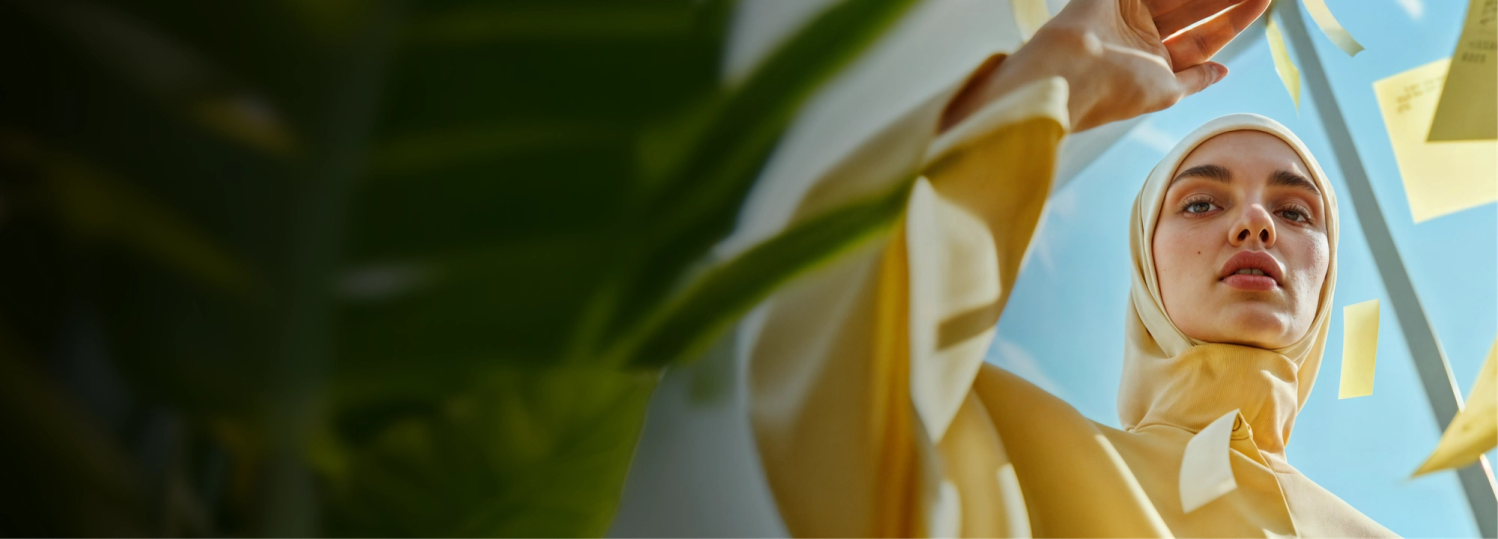
Marketing and design are treated like different species. Stereotypes offer a “suits vs. arts” dichotomy: savvy technocrats waving pie charts at eccentric bohemians, both paying half attention to one another while they consider where to go for brunch.
If ever it were true, it’s not anymore. Marketing and design have bled into one another so thoroughly that it’s not uncommon for marketers to be noodling around with Photoshop; nor designers flipping through HubSpot. But while both can learn from dipping a toe in each others’ worlds, there’s something wrong when marketers are forced to use design tools.
It’s one thing for a marketer to play around with Illustrator of their own volition, but that’s not usually the case. Most often, they’re using marketing design tools to cover a gap in their company’s design model.
The marketer adjusting font sizes on an ad or social template is going beyond their skill set to compensate for design’s overflowing pipeline. They’re doing it because no one else has the time.
Should Marketers Use Design Tools?
Don’t get the wrong impression—there’s a time and place for marketers to dip their toe in design’s waters. If all you need is some occasional template-based creative (where all you need to do is place your copy in the predetermined copy space), some marketing design tools, including the best photo editing app, can help expedite the time to publish. No intermediary, just type, save and hit post.
But if marketing is finding itself performing more complicated design tasks, it’s worth asking whether the company’s design workload is putting strain on marketing and design alike. For all the overlap, both marketers and designers should still be doing their own jobs.
The combined hours a marketer spends swapping through layers—with far less efficacy than that of a designer, mind you—are hours taken away from driving key marketing initiatives.
Here, we’ll outline the most common marketing design tools, and explain if and when they’re right for your marketing needs.
1. Adobe Photoshop
Photoshop is so ubiquitous your grandpa has heard of it. It’s its own verb: “Photoshopped” is the go-to word for doctored images. How many design tools are in the Oxford dictionary?
Despite its prevalence, it’s still used primarily as a professional raster graphics (pixel-based) editor. It’s got more tools on hand than any other photo editor you’ll find, and is generally fast on the appropriate hardware. Designers and artists have been using it to make marketing creative, social media marketing designs and digital art, and they continue to find interesting ways to tweak and improve images. What’s more, it’s come over time to allow for basic animations and even illustrations. In the realm of image editing, there is no higher throne than that of Photoshop.
Is it right for you?
Photoshop is a fantastic tool for editing images if you know what you’re doing. Thing is, most marketers can’t use Photoshop like designers can. Unless they come from a design background, or are putting countless hours into learning design practices (they’re not), the average marketer will only be capable of performing very basic tasks.
That’s fine if all an image needs is some light color correction, but this is your creative we’re talking about. Basic image edits are not substantial when it comes to branding. For one, the resulting material won’t look nearly as good as what your in-house designers produce on a daily basis. We’re in a visually dominated market, and falling short of top form means falling off the map as consumers scroll on.
The resulting creative is also likely to be at odds with design’s output, making for an inconsistent experience that weakens the brand. Design goes to great lengths to make sure every material is calibrated for peak performance on every possible publishing medium. Unless you’ve taken a couple courses on photo editing, your images aren’t going to match the rest of your brand’s oeuvre.
Pending your skill in the design arts, it’s probably in your interest to leave Photoshopping to design teams. If you’re taking on Photoshop duties to cover for low capacity on design’s part, think about partnering with a dedicated design team to ensure quality/brand alignment without adding heads. Marketing’s mind should be on strategy.
2. CorelDraw
Though it doesn’t boast the trophy of its own verb, CorelDraw is still a feature-rich vector editor used by plenty of design professionals today. Where Photoshop casts a wide net in its features for maximum appeal, CorelDraw is more often used for business purposes. CorelDRAW is mostly used for print. It’s best for creating vector art, logo designs, banners, flyers and the like.
Corel’s platform is most often used to create images for print, making them great for things like brochures and newsletters.
Is it right for you?
If all a marketer needs to do is to print some business cards, they might be able to get away with a cursory knowledge of CorelDraw. Otherwise, they’ll run into the Photoshop quandary: Only able to perform basic tasks in a world where “basic” graphics don’t cut it.
CorelDraw’s specialization in print-ready images also shrinks its use case for many modern marketers, who are continuing to shift towards an all-digital M.O.
3. Adobe Illustrator
Illustrator is Adobe’s vector-based editing software. It’s frequently used to create graphics, logos, cartoons, and fonts—anything that may need to be displayed in different sizes. Put bluntly, Illustrator is more for making things, where Photoshop is better for editing them.
It’s widely used by graphic designers, web designers, visual artists and professional illustrators to create high quality marketing creative and artwork. Illustrator makes use of some pretty sophisticated drawing tools that reduce the time designers take to create illustrations.
As with Photoshop, it’s often used for social media marketing design.
Is it right for you?
Where tools like Photoshop are at least based around editing existing images, designing images and graphics is where the wheels start to come off for marketers. It’s one thing to make minor adjustments to a thing, it’s another to make the thing altogether.
It’s a truth best spoken plainly: Marketers shouldn’t be marketing design tools like Illustrator. Something’s gone wrong if you’re tweaking vectors between digital ad campaigns, and it’s time to evaluate how your design model is working for you (rather than digging in deeper by learning design software yourself).
Graphic creation should be in the hands of graphic designers. If the in-house team doesn’t have the bandwidth to support every marketing goal with the necessary creative, consider dedicated design services perfect for marketing teams that can.
4. Sketch
Sketch is experience-based design. It’s used mostly for designing the UI and UX of web pages and mobile apps. The files designed in Sketch are saved in the program’s own file format (“.sketch”), though they can be opened in Photoshop, Illustrator and other programs.
With far fewer features than those previously mentioned, it’s not an obvious go-to for marketing design. Its strength is in its specialization. It builds wireframes: screen blueprints that represent the “skeleton” framework of a website.
Sketch is exclusive to Mac users, where other tools listed here are accessible on any operating system.
Is it right for you?
If you’re a UI or UX designer, heck yes it is. If you’re a marketer, probably not. The only marketers you might find tooling around with web and mobile design software are ones at reeeally small companies. They may be one of few people with enough technical knowledge to perform basic tasks in design software, and get stuck building landing pages because no one else can.
This isn’t just regular graphic design, it’s specialized design. The further a marketer goes into someone else’s specialty, the higher the chance of error or inconsistency. Unless you’re the only one on your team with access to creative platforms, leave the wireframes to the wire handlers—design professionals with specialized experience creating engaging and functional user interfaces and experiences.
5. Adobe InDesign
If it’s going on multiple pages, it’s going in InDesign. The leading software for creating and publishing multi-page documents, it’s the popular choice for published works. White papers, guides, books, magazines, stationery, resumes, pamphlets, annual reports, catalogs, interactive digital publications and EPUBs are all made easier through InDesign.
In an InDesign document, a designer can format text, vector art and images to create a page more dynamic than a simple block of text, if they so choose. It’s indispensable in creative marketing, and you’re unlikely to find a single designer on your team who doesn’t have it on their computer.
Is it right for you?
The multi-page layout is a wonder for marketing materials, with most promotional assets, marketing emails and catalogs being built in InDesign. It’s easy to see why marketers try their hand at making creative to support their initiatives with it.
If things are carefully templatized and leave little room for error, it’s possible for marketers to create certain simple, repeatable assets without fuss. But for anything more complicated than a branded email, a designer is the best way to ensure creative quality and consistency.
Let Designs Teams Lead Design
It’s endearing that we’re coming to a place of greater understanding between marketing and design teams. We can’t do our jobs without one another, and learning what goes into one another’s work is the fastest way to build empathy and improve collaboration.
It’s when we find ourselves regularly reaching outside our department that we start to stretch ourselves thin. We’re specialized for a reason, and businesses derive the most value from maximizing our core competencies. If marketers are going to make using marketing design tools part of their roles, they may as well work the accounts payable while they’re at it.
Both marketing and design see the most ROI when they bet on dedicated design partners to divert the overflow—allowing for brand-aligned, professional-grade creative with fast turnaround and zero heads added. Superside can be that partner.
It sounds obvious, but it’s easier to meet marketing goals when your time is dedicated to driving marketing goals. The best tool you have for marketing is your own savvy, pie-chart wielding technocrat brain. The best design marketing tool you have is dedicated design.
















